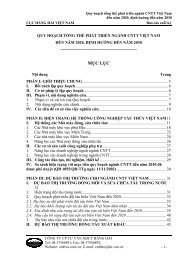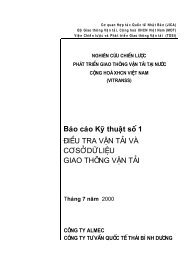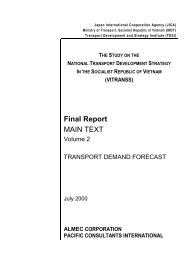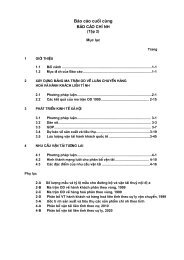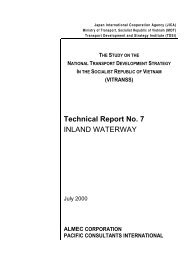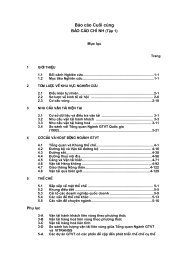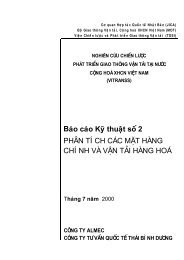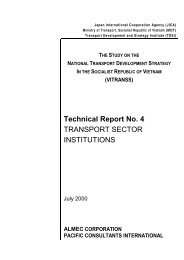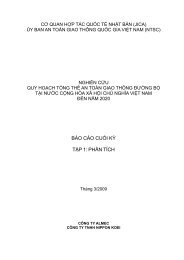Technical Report No. 8 PORT AND SHIPPING
Technical Report No. 8 PORT AND SHIPPING
Technical Report No. 8 PORT AND SHIPPING
You also want an ePaper? Increase the reach of your titles
YUMPU automatically turns print PDFs into web optimized ePapers that Google loves.
I-4-17<br />
Vietnam National Transport Strategy Study (VITRANSS)<br />
<strong>Technical</strong> <strong>Report</strong> <strong>No</strong>. 8<br />
Shipping and Ports<br />
fourth criterion will really depend on the economic development in the south<br />
and the development policy on regional port system that will encourage<br />
container cargo trade to Vung Tau. Last but not least is Vietnam’s inherent<br />
weakness. Hong Kong and Singapore have exerted effort to attract the<br />
capital investment of foreign shipping lines as well as forwarders. Today,<br />
Singapore aims to become a regional business hub, encouraging foreign<br />
shipping lines to locate their regional headquarters in Singapore by giving<br />
them tax incentives. On the other hand, the Vietnamese government has not<br />
opened the transport industry to foreign investment. According to the ASEAN<br />
Framework Agreement on Services and its Protocols (CPC7212),<br />
government:<br />
(1) Allows foreign shipping companies to establish a representative office<br />
only;<br />
(2) Restricts representative offices of foreign shipping companies from<br />
conducting business activities in Vietnam; and<br />
(3) Requires foreign shipping companies to appoint their Vietnamese<br />
shipping agency counterpart as its general agent to supply maritime<br />
services.<br />
4) A Transshipment Port in the Central Region<br />
The VITRANSS Study Team recognizes some issues related to<br />
transshipment port in central Vietnam. According to MOT Decision <strong>No</strong>.<br />
608/QD-GTVT (13 March 1999), the Vietnamese government has a study<br />
plan to create a transshipment port facility at two candidate sites, i.e., Chan<br />
May and Vang Phong in the central region. However, when compared with<br />
the Vung Tau project, the viability of both sites is lower due to scarce<br />
hinterland population and inactive economy even if some parts of Lao and<br />
Cambodia are included.<br />
It is true that there is some opportunity for a mega shipping line to construct a<br />
private transshipment port regardless of hinterland development. Evergreen,<br />
ranking second as the global container carrier, made such MOUs with the<br />
Indonesian government for a port at Batam Island (20km south from<br />
Singapore) in 1993 and the Vietnamese government at Vung Tau in 1996.<br />
However, both MOUs are not in effect anymore, thus hindering port<br />
construction.<br />
Moreover, due to the inconvenient location, a transshipment port in the<br />
central region would apparently burden many shippers and consignees with<br />
additional transport costs. Therefore the project cannot justify tapping any<br />
public fund for port construction and related infrastructure development.



